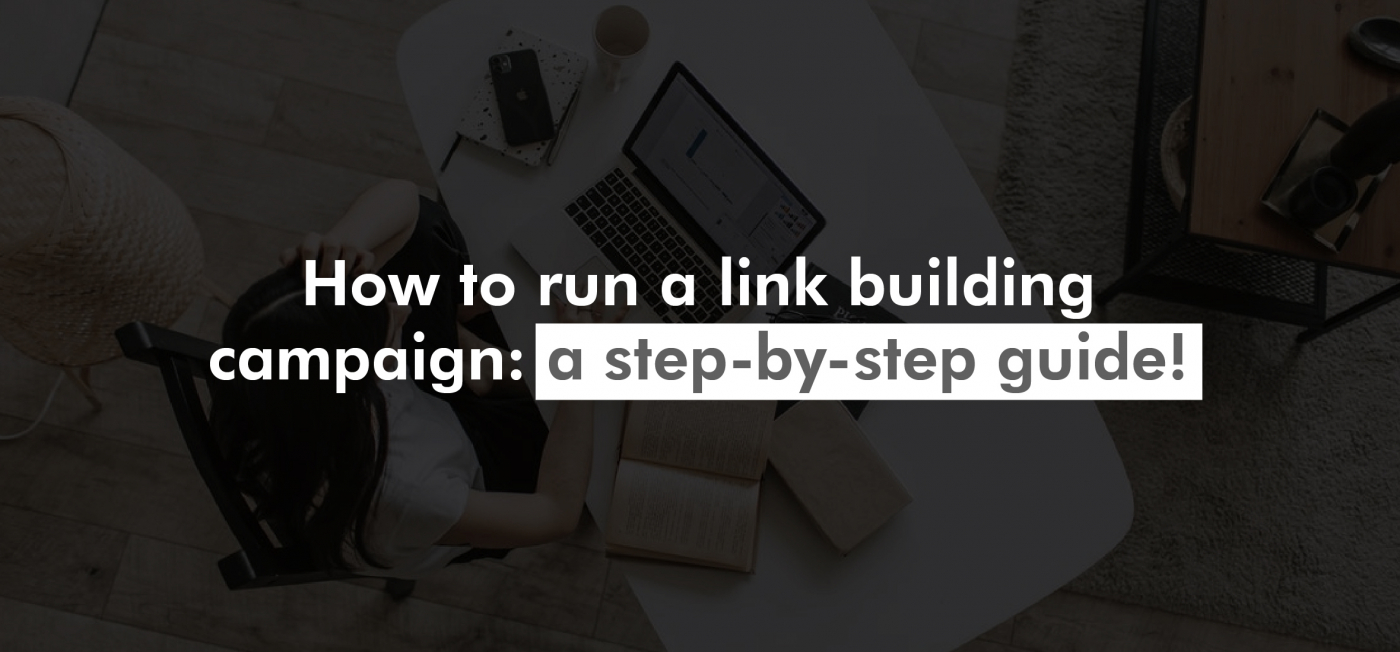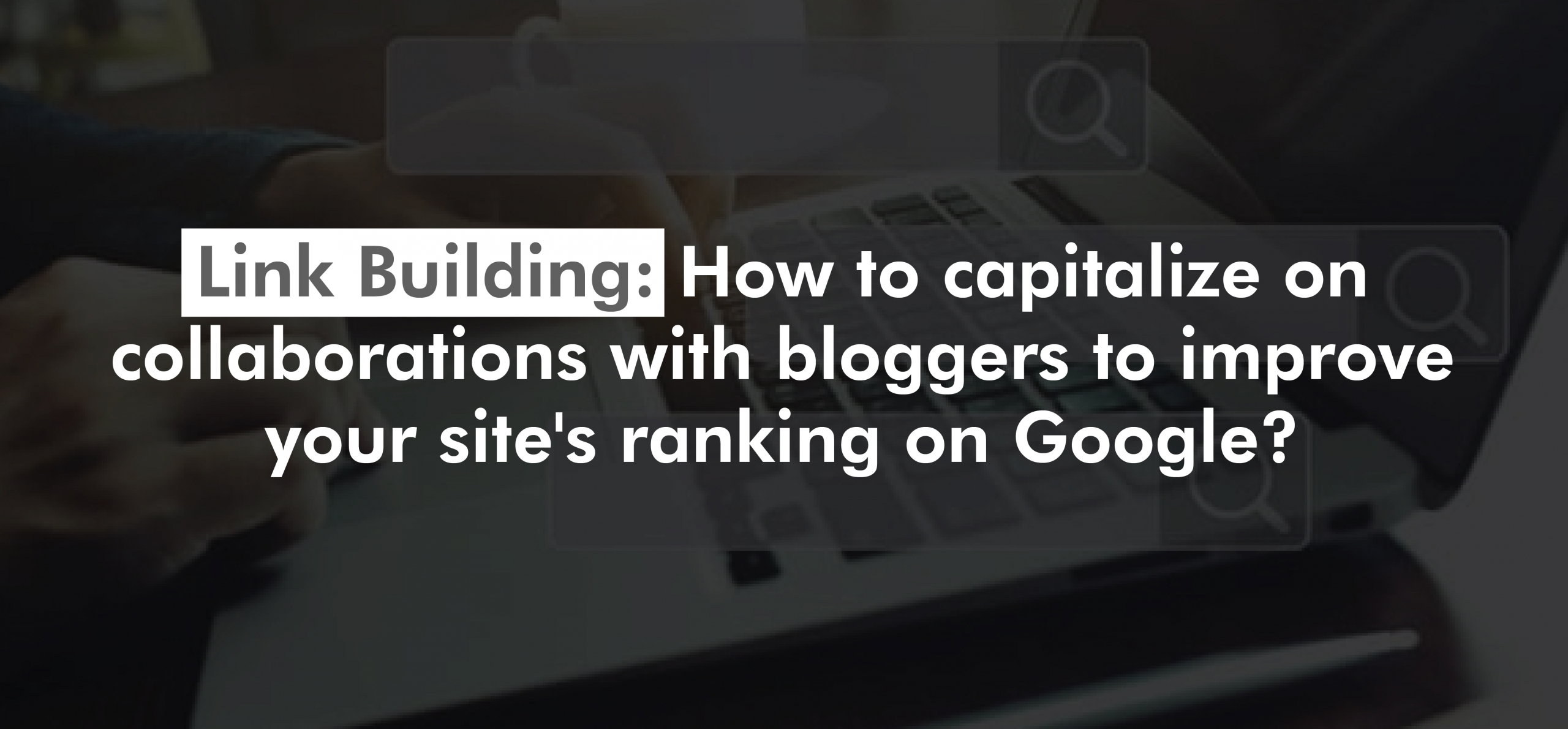1# ¿What is a link-building campaign?
A link-building campaign is the process of increasing the number of links directed to your website, usually accompanied by some sort of overall objective. Assets belonging to the website are used to get those links. The assets can be anything from content and news to products and services.

2# Structuring a link building campaign
There are several components to a link-building campaign; some will be crucial to success and others will be helpful, but not necessarily essential. Much depends on a combination of the assets and resources available.
Setting objectives
Link building is a form of online marketing and, as with any form of marketing, you should start with goals. Knowing your campaign objectives from the start helps ensure that you are creating a strategy that will give you the highest chance of success. You should also make sure that your campaign objectives are closely aligned with the overall objectives. For example, setting up ten targeted links to your site is not a good goal if ten links have no impact on the overall success of your business.
Here we run into a little problem. We know that links are a strong part of search engine ranking algorithms. So, won’t achieving more links as a goal help ranking? Helping positioning favors traffic gain, which brings more customers, right? This is all true, but the problem is that sometimes it can take time for the links to start having a positive impact on the overall ranking. It’s not as simple as getting links one day and seeing improvements the next. This is particularly true in competitive industries. And it poses a problem for SEO analysts because it can be difficult to prove that a link-building campaign is successful, even if it meets certain objectives.
won’t achieving more links as a goal help ranking? Helping positioning favors traffic gain, which brings more customers, right? This is all true, but the problem is that sometimes it can take time for the links to start having a positive impact on the overall ranking. It’s not as simple as getting links one day and seeing improvements the next. This is particularly true in competitive industries. And it poses a problem for SEO analysts because it can be difficult to prove that a link-building campaign is successful, even if it meets certain objectives.
For this reason, it is very important to not only set realistic goals but to make sure that the goals you set are smarter than simply “getting x amount of targeted links”. The goals should be aligned with real organizational interests and will ultimately have a positive impact on your business’s bottom line. For example, you might want to increase search engine traffic to increase your sales. At the same time, you need to teach those around you that SEO and link building do not succeed overnight and that results are not instantaneous. As in any good marketing, the focus should be on long-term gains, not quick wins.
 Finding your assets
Finding your assets
At the heart of any link-building campaign is the asset you are going to use to attract and earn links. This can also be known as the hook that will get people interested in what you offer and tempted to open your link. Assets will vary according to the business, and one should identify what asset each one has that could be interesting to others and could be used in link building.
Some examples of assets:
- Content
- Data
- Products
- Services
- People
Another asset used by the most aggressive SEO analysts is money. All assets require some sort of investment, but these analysts approach link acquisition as a pure transaction. Buying links is strictly against Google’s guidelines, and if a page is found to be doing so, it can mean a significant penalty and a consequent loss of traffic. Buying links is risky and, generally, the risks outweigh the potential loss, so we strongly recommend against it.
Also, you have to make sure that the assets you create are relevant to the audience you want to attract. Aleyda Solis put together a tutorial worth watching.
What types of links do you need?
When defining the strategy for your link-building campaign, you need to think about the types of links you need to get. There are several types to consider.
- Links to your home page
- Links to “deep” pages (such as a product or category page)
- Links containing your brand or company name
- Links containing the keywords you are looking for
Additionally, there are some combinations of those mentioned above, such as a link that mentions the brand and goes to a deep page. To identify what kind of links you need, you need to start with a detailed link analysis of your current website as well as looking at how you rank for certain keywords compared to your competitors. You can use OpenSite Explorer to perform this type of analysis and see how your link is currently performing.
The analysis will show you your opportunities for improvement. For example, you might realize that you are not ranking for one of your main keywords. After analyzing your linking a bit, you realize that you have no targeted links to your page containing this keyword or you realize that the most relevant deep page contains no targeted links at all. If you identify something like this, you have a tangible problem to solve. In this case, it may mean that your strategy includes creating targeted links to your deep page that currently has no links and does not rank for the keywords you want.
Finding a target for your link
The first thing you need to think about is what kind of people you should contact, as you want to make sure you’re contacting people who are interested in your content. If you contact random people, your response rate will be much lower and you are likely to give your site – and yourself – a bad reputation.
Ideally, before you start a link-building campaign, you should have a good idea of who you think will be interested in what you’re doing. If you create a piece of content with targeted links, such as an infographic, you should ask yourself from the beginning who will be interested in it, and more importantly, who will be interested enough to place a targeted link to it.
This last part is crucial. While it may be fairly easy for you to find people to look at your content, it’s a whole other level of interest to get them to link to it. Placing outbound links takes some effort and time, so you need someone to be interested enough in your content. The barrier to getting your content shared on social networks is much lower. There are more people with Twitter or Facebook accounts than with websites or blogs, which makes it easier to get shared on social media. So how do you get people interested enough to link to your content?
First, you need to find a hook that gets people interested. Second, you need to work this hook into your content from the start. If you delay creating the hook until the moment you start outreach, you may find that no one is interested in the thrust of your content, with the result that you have spent a lot of time creating content that no one wants to link to.
Some hooks to think about could be the following:
- News
- Fun
- Controversial
- Data visualization
- Competition
- Ego Hook
- Long detail content
There are many hooks, but the ones mentioned above should help you think about what you can offer people so that they will place outbound links to your content.
In addition, a simple exercise is to go to your Facebook news feed and see what links people share. Make a note of what feature each one has and try to find patterns. It is likely that the links shared on Facebook are funny, because many people use this platform for personal stuff and may not share more serious content, except for big news or controversial topics. Now look at the news on your Twitter feed, note what kind of links are being shared there, and ask yourself why. You might find that different content is being shared on Twitter than on Facebook.
 Identifying your ideal audience for links
Identifying your ideal audience for links
Once you have your idea mapped out, it shouldn’t be hard to find out who is going to be among your ideal audience. Generally, you just need to think about issues related to your content. Let’s look at an example.
Imagine you’re putting together a piece of content titled “The Ultimate Guide to Baking Perfect Cupcakes”. You’re producing this content because you own a bakery that sells cupcakes among other lovely things. Who might be interested in this guide?
- Food blogger: the obvious choice.
- Parent bloggers: who may want to teach their kids how to make cupcakes and your guide will show them how to do it.
- Recipe pages: because your guide will contain lots of great recipes for different types of cupcakes.
- Party pages: no party is complete without a supply of cupcakes.
With a minute or two of thought, we found four different types of websites that may be interested in your cupcake guide. Now we can start doing more thorough research to get a better idea of whether we have a good chance of earning a link from them.
Techniques to hit the target with your link
In this section, we will outline a few simple techniques you can use to turn your concept of food bloggers into a comprehensive list of websites you can contact.
Find a list of bloggers
By far the easiest way to get started is to do a Google search like this:

This single search gave us many great lists to search through. The great advantage of using this technique is that someone else has already done the hard work of compiling the list for you.
Once you’ve found a list like this, you can quickly grab all the URLs from the page using a tool like a Scraper, which is a Google Chrome plug-in. Right-click on one of the URLs and click on “Scrape similar”.

You can then copy the entire list to Google Docs or another spreadsheet. And from there, you can copy and paste all the URLs into a tool like URL opener, which will open all the URLs with a single click. You can then browse through them all, decide if they are relevant to your content and, if they are, find the contact details.
Find bloggers on Twitter
Followerwonk is a fantastic tool from Moz. It lets you do a lot of cool things with your Twitter account, but the feature we’re interested in is searching Twitter bios. Let’s try searching for “cupcake blogger” to see if we can find someone on Twitter who has mentioned “cupcake blogger” in their bio.
You can select more options like several followers and location but for now, we just want to keep the search pretty open. This search resulted in 12 people found on Twitter.

Then, you will be able to download these results in a spreadsheet which makes it easier to sort them. It will tell us, also, if they have a website or not:

Out of the 12 results, we found 8 web pages:
Not a bad lead for a few minutes of work! This is super relevant to our content; we know we have a good chance of getting some links or at least getting some good feedback from the blogger.
Advanced search queries
There are several ways to search on Google that are not immediately obvious to us: the users. We’re used to searching keyword strings and that’s how 99% of Google users search. But there is a set of search tools available to us that can make our results much more targeted and specific to what we need them for.
For link building, this means we can filter out web pages that may not be useful to us and spend our time looking at the ones that are. Here are some examples of using different advanced searches.

Note the “inurl:resources” part. This tells Google to only show results that have the word “resources” in the URL. One of the, for example, blogs it gives us, could be a target for linking because your ultimate guide to cupcakes would be an interesting resource for visitors to this blog. Therefore, contacting the blog owner and asking him to include your guide as a resource may represent a relevant link for you.
Let’s see another example:

We combine two advanced searches here. First, we use the intitle:resources, which tells Google to only show results that have the word “resources” in the page title. This is useful because sometimes the word may not be used in the URL, so our last search (using inurl:) won’t find it.
We have also used quotation marks around the word cupcakes. This tells Google to only return results that mention cupcakes on the page. This is useful, in this case, because the search for food bloggers is probably too broad and would have required searching through a lot of web pages that might not be functional for the topic of cupcakes.
You now have three solid methods of finding relevant targets for links. At this point, you probably have a big list in a spreadsheet, but we need to do a little more before we contact the site owners.
Finding out more about the people we are looking for
If you want to have a high level of response to your search, you need to spend a little time making sure that the web pages you found are as relevant as possible.
You can do this by taking the trouble to learn about your desired bloggers. Visit their sites, read their content, and try to get a sense of their likes and dislikes. Look at their social networks, such as Twitter, to see what links they have shared recently. In particular, pay close attention to whether or not they share someone else’s content or just promote their own. Ideally, you want to find some evidence that they share external resources because that’s what you’re going to ask them to do.
As you look at each web page, take some notes on what they have shared and what they are interested in. This is crucial because you will need the information later when you contact them. Otherwise, you’ll be sending them a generic email without any personalization.
A good trick to use here is to put the URL of the blog in a tool like TagCrown, which will analyze the content of the page and show you which words are mentioned the most.
Finding contact details
Once you’ve decided that the blog is within your desired audience and seems relevant, you’ll need to find the contact details.
Look at the header and footer first
Most of the time, you will find a link to a contact page in the header or footer of a website, so check those areas first. If you don’t find a contact note, try the “about us” page, which often displays contact details.
Install ToutApp for Google Chorme
ToutApp is a small Google Chrome add-on that will try to track down email addresses on a page. When it has found one, it will be highlighted in the Chrome toolbar and you can click on it to find the email address.
Prioritizing objectives for links
At this point, you will probably have a large list of link targets and need to prioritize and group them so that you can customize your message for efficiency. And there are several ways to prioritize your link targets for action:
- By domain metrics, for example, PageRank or DomainAuthority.
- By the blogger’s influence, e.g. number of followers on Twitter.
- By link likelihood, e.g., a cupcake blogger vs. a general food blogger.
Domain metrics
For now, all you need to know is that these metrics measure the value of link targets as well as the value of individual links. There are two main domain metrics when filtering and sorting link targets: PageRank and DomainAuthority. You could, of course, gather the domain metrics for each web page, one by one, but that would take much longer; there are tools available that let you gather that information in bulk.
You can get the PageRank for your targets using Excel and the SEO tools add-in for Excel. You can also get DomainAuthority in your Excel spreadsheet using the Links API add-in developed by SEOgadget.
Once you have these metrics, you can perform a simple Excel ranking from highest to lowest; if you choose, you can remove link targets that don’t have a high enough domain metric. This is especially helpful if you have a large set of sites and don’t feel you have the time to contact them all. We tend to rank them with PageRank and get rid of everything below 1. If we have a high number of results, we may also get rid of everything below 2.
Then, we rank with DomainAuthority and generally get rid of anything below DA30 or DA35 if it is a very long list. However, this is not an exact science, because a new web page that may be very good and relevant may not have accumulated enough PageRank or DomainAuthority yet. However, if you have a long list of potential link targets, you will want to be quite aggressive in restricting it so that you have a remaining set of good quality pages to work with.
Blogger Influence
An indispensable part of getting as many views on your content as possible is gaining influencers to share it. Finding a single influencer to share your content can lead to a huge ripple effect because many of their followers will also share it. So, even if a blogger doesn’t seem to be associated with a particularly strong domain, don’t rule them out before you’ve checked how influential they are on social media.
Again, you can simply go through their social profiles one by one to find out how many followers they have, etc. Remember how we used Followerwonk to find good people to follow? Well, Followerwonk will also give you metrics about each person, for example, how many people follow them and what their influence score is. If you download a CSV from Followerwonk, you will see a column that includes the influence score.
Simply look in this column to see which Twitter profiles are the most influential. These are probably the people you need to focus on first because they can share content with a large number of followers.
Probability of generating a link
This is where your search manual comes back into play. As you browse potential link targets, you should try to assess how likely they are to link to your content. No tool can do that for you and you are going to have to come up with your way of considering this. A simple way might be to rate them on a scale of 1 to 5, with 1 being “not likely to generate a link at all” and 5 being “very likely to generate a link”.
The questions you should ask yourself when giving them a score are as follows:
- Have they shared external content before?
- Are they highly relevant to my content (e.g., cupcake bloggers should score better than food bloggers in general)?
- Is their blog active, e.g., have they made a post in the last month?
These questions should give you an indicator of how likely they are to link to your content.
Once you have collected all this information, you should sort it so that you have a list of bloggers who….:
- Are likely to generate a link to your content
- Have high domain metrics
- Have a large social following
So, finally, these are the websites you should contact first and with messages that are well personalized and tailored to them. Take another look at their websites and try to find clues that can guide you on what to include in your email. This will help to make your message look genuine and avoid looking like just another depersonalized email.
These websites also have the power to seed your content, which means that other websites will also be aware of your content, perhaps even avoiding the need for you to contact them.

#3 Disclosure
Now we need to dive right in and tell people about our great content or campaign. You should start with your high-level targets because not only will they be able to get you good results if they respond well, but you’ll be able to use them as proof, as a social example later on, when you reach out to smaller websites. If smaller sites see that an influencer has liked and shared your content, they will be much more open to you when you contact them.
You are contacting a real person
There is no machine behind the web page that chooses whether or not to respond to you: it’s a real person who probably receives a lot of disclosure mails. These are people who deserve to have a little bit of your time to realize that you are not just another spammer or an automated mail program. Ask yourself, for example, how you would talk to them if you met them in real life.
Also, we don’t think any blogger wakes up in the morning thinking “Mmm… who should I link to today?”. They never plan to link to your content; they have to work on other things, which, perhaps, takes priority over what you’re going to offer them. For this reason, you shouldn’t assume that the blogger owes you anything; it’s your job to tell them why you deserve their time, attention, and help.
If the idea of contacting a real person and telling them about your content makes you feel a little nervous, then double-check to make sure your content is as shareable and valuable as you think it is. While overconfidence can be a mistake, you have to feel confident enough with your idea to believe that real people will react well. If you meet someone while walking down the street and show them what you’ve been working on, will they react well? If not, you’ll probably have to work on it some more before you go out and spread it around.
How to elaborate your message
Remember that the bloggers you are contacting may be very busy people, even more so if they have popular blogs with a large following. Your message should be detailed enough to explain why they should care, but also short enough for them to read it all and not get bored or, worse, delete it.
Here are some points to keep in mind when you create your message:
- Tell them why they should care.
- Tell them what action you want them to take.
- Show them that you really aren’t a spammer.
Tell them why they should care
If you’re at this point with your link-building campaign, you shouldn’t be stuck writing this. If you’ve been working on a piece of content, from the beginning of its creation, you should have this answer determined. “Why should anyone care enough about this to place a link to it?”. Remember our previous hooks:
- News
- Fun
- Controversial
- Data visualization
- Competition
- Ego Hook
- Content
Does your content fall into any of these hooks? If not, is there anything else unique about your content that might get someone interested in it?
The blogger you’re contacting is perhaps active in your industry and will know a lot about the subject matter of your content, so take a look at their most recent posts and, if possible, relate them to the reason you think they’ll care.
As an example, if you’re reaching out to a blogger who is a big movie fan, chances are they’ve posted about a movie they liked. If your content includes movies and includes the movie the blogger wrote about, mention it to them! Not only does this tell them why they should care about your content, but it also shows that you’ve taken the time to read their blog, rather than just sending them a model email.
Tell them what action you would like them to take.
Many contact emails skirt around the issue of what the sender truly wants. Some may not dare to mention the word link or SEO for fear that the blogger will mark them as spam. However, we need to find a way for the blogger to take the action we want. Sometimes, the action may not just be about the link. It can be several other things, including:
- Share your content on social networks such as Twitter, Facebook, or Google+.
- Incorporate your content if it is an infographic or a small application.
- Accept a guest post from you, relating to your content and place a link to it.
- Have the blogger write a review of your content and link to it.
These are just a few examples, but you can quickly see that there are different levels of action and that the barriers to each are different. For example, taking the time to write a piece of editorial content on your topic and placing a link to your content is a huge demand for the blogger. By contrast, simply sharing on their social networks may only take them a few minutes at most.
You must consider this when creating your message and be aware that the more you ask of the blogger, the more irresistible and interesting your content needs to be.
The actions we mentioned are not exclusive either. You can achieve great results if an influential blogger posts a link to your content AND shares a link on social media. At the same time, you can use a subtle tactic if you receive a somewhat negative response. For example, if the first action you try to get the blogger to take is to write an editorial piece on their site and they refuse, but like what you did, you can follow up by asking them if they would like to tweet you. This is useful if you are contacting an influential blogger who may not budge once they say no, but who has a large social following with whom they would have no problem sharing content.
Another thing you can do in this case is to offer to write a guest post for them. This is a good solution if they like the content, but don’t have enough time to write about it. You’ll want to leave this type of insistence for very strong websites because it will take extra time and resources to pull it off.

Show them that you are the real thing and not a spammer
This is about personalizing your message so that the blogger doesn’t go straight to the spam or delete button. Remember that popular bloggers will receive thousands of contact emails, so it’s worth taking the time to make yours a little different and personalized for them. There are many ways to do this without adding too much time to your process or compromising quality.
Here are a few ways:
- Use their name
- Use a good subject line
- Mention something specific about their work
- Use an appropriate email signature
- Use a genuine email address
- Use your location (if relevant)
Let’s look at this in more detail:
Use their name. It sounds simple and straightforward, but many people don’t take the time to do this, even though it doesn’t take that much time. It can make a big difference and give you that extra bit of attention you need to get them the key to your message.
And here are a couple of tips for finding someone’s name:
- Check the About page…
- Check the author’s name on the posts.
- Click on their social network accounts to see if their name is listed there.
- Enter their email in a tool like Rapportive (Gmail) or Xobni (Outlook) that will search for additional information connected to any email.
If you can’t find their name at all, using something like “Hi, how are you?” is fine, but avoid using things like “Hi, Webmaster” or “Hi, blogger”, because these are traditionally used by mass spammers and you don’t want to be associated with them.
Use a good subject line. Before the blogger has even opened your email, he/she will see the subject line. If they don’t like what they see there, your email will probably be deleted directly and they won’t even waste the time to read it. This is the worst thing that can happen to you because you have no chance to talk to them or get any feedback at all.
There is another important item to remember here: a bad subject can trigger spam filters and result in your email being marked as unwanted. In that case, you would be relying on the blogger to check their spam folder (many won’t) and see that your email is, in fact, genuine. Either way, this is not a good place to be.
Here are some tips for writing a good subject line:
- Keep it short and concise.
- Mention the website if possible.
- Avoid excessive capitalization.
- Mention something specific to your site (like the name).
- Avoid things like “link exchange” or “link request”.
Here are some really useful and insightful articles from Hubspot and Smart Insights on the good stuff.
Mention something specific about their work. This is very important if you want to show that you didn’t send the same email template to many bloggers. Mentioning something specific about the blogger you are contacting or their blog can help you show that you have taken the trouble to do some research before sending the email. This also gives you a great opportunity to introduce your content and why the blogger should be interested.
Let’s look at several ways you can mention something specific:
- See the topics of recent posts.
- See the recent tweets and retweets.
- See the comments they have made on posts.
- See their “About” page and search for personal interests.
- View their Twitter biography.
All this can give you valuable information about the blogger that you can later include in your email. Here is an example of what an email could look like:
I read a post on your blog about the best movie of 2014 so far. I couldn’t agree more and would definitely put The Wolf of Wall Street in my top movies as well. I actually wanted to share with you something related to this [LINK], it’s a visualization of the top-grossing movies of 2014 along with production costs and earnings. I thought, given your last post and your interest in movies, that it might be of use to you.
That didn’t take too long to write and was the result of searching the titles of a couple of recent posts written by the blogger I’m contacting. It would be quite difficult (practically impossible) for an anti-spam program to recognize this unique and specific email as unwanted, so it is likely to pass the anti-spam test.
Use an appropriate email signature. This is a small tip and takes no time at all. You should place a proper email signature at the end of all your contact emails that include things like:
- Your name
- Your professional title
- The URL of the site you represent
- Your phone number
- Your social media accounts (if related to work)
You could end up with something that looks something like this:
Jorge Pérez
Online Marketing Executive
01234 567 8910
twitter.com/jperez
This is another sign to the blogger that you are a real person. They may check your website, your social activity, or even call you. Again, someone who is looking to spam is not going to do this.
Use a genuine email address. There is some debate on this point. Some SEO analysts strongly believe that you should always use an email from the client you represent rather than a regular one from your SEO company. So if you are going to contact Zappos, you should use myname@zappos.com rather than myname@puntorojoagency.com.
This argument tends to be set rigidly against the fact that SEOs can have a bad reputation; for example, if the blogger sees that you are writing to them from an SEO company’s email, they may automatically get rid of the email.
One thing we would recommend is to be careful about using free email address providers such as Gmail, Hotmail, or Yahoo. Unfortunately, many spammers take advantage of these free services by turning them into a sign that you are not a genuine person.
Use your location (if relevant). Opportunities to use this tip may be few and far between, but if you get the chance, it will help you appear more genuine and sow the seeds of a good relationship.
The idea is that if you are contacting a blogger who happens to live in the same city as your client, mention them in your email. This allows you to work on the local aspect and say something like:
Since we are also based in Buenos Aires, we wanted to have the opportunity to talk to local bloggers like you and share some of the content we have been working on that may be of interest to you.
You can take it a step further and even meet bloggers for lunch or coffee. There’s no better way to show that you’re a real, genuine person than by buying someone coffee (and cupcakes!). If you find that there are several bloggers in your area, setting up a meeting can also be a great way to build genuine relationships and get them on board with your brand.

#4 Follow-up
You’ve probably already built so many links as a result of following up with people after the first email. People are busy; popular bloggers will get a lot of emails and, in a world where we can check emails while doing anything else, your email can easily get buried and forgotten.
For this reason alone, it’s worth making sure to follow up with everyone you contact if they don’t respond the first time. The added value here is that you also reinforce the idea that you are a real person and not an automated program.
To follow up properly, you need to keep your outreach as organized as possible and record the responses you receive – the last thing you want is to follow up with someone who is already generating links for you!
There are several ways to stay organized with your outreach, from a very simple Excel spreadsheet to CRM systems. Let’s take a look at some of these options.
An Excel spreadsheet
When you’re just starting out doing link building, a spreadsheet will serve you well. Even at an intermediate level, it can do the job, but it can become too big and heavy if you are working on multiple campaigns at the same time.
A simple Excel spreadsheet can start out looking like this:
It can be as simple as this. You can add an extra column for any specific data or metrics you are interested in, but this will do the trick.
However, after using it for a while, it can get a little difficult to work with. For example, what happens when you start a second campaign and want to contact your bloggers again? It is possible to do it with a sufficiently advanced Excel system, but it can get a bit confusing.
Special tools for disclosure management
At this point, you may need to invest in a system to handle stronger and more focused outreach. There are several options here such as BuzzStream and Raven which are probably the most popular for this type of task.
Boomerang
Boomerang is a free Gmail add-on with a nice feature that we can use to track the emails we send. When sending an email, you can tell Boomerang to send you an email if you don’t get a reply within a certain period of time, for example, two days.
In this case, if the person I am writing to does not reply within two days, Boomerang will send me the email back. At that point, I can quickly follow up and the great thing is that I can be sure I’m not emailing the wrong person who might have already responded.
Combine this with pre-determined responses (outlined below) and you have an effective and fast way to track all your link targets.
How to follow up
In terms of exactly how to follow up with people, our advice is to keep the email short and to the point. You’ve already sent them an email outlining all the necessary details they needed, so you don’t have to repeat everything again. If you reply to the email you already sent, most email programs will include your original email, so the person can scroll down and easily find what they want.
In terms of what to say, something as simple as this can work.
Hi Jorge.
I just wanted to follow up on the email I sent you a few days ago [posted above] about the essential backpacker’s guide I put together. It would be great to get your feedback, if possible, and see if it’s something you might be interested in sharing with your blog readers.
Hope to hear from you soon.
Thanks!
Tomás
It is short and friendly, says what you need and is polite.
In general, we follow up with a person only once. If we still don’t get a response, we will probably move on to other contacts and not call you again for this particular campaign. If you continue to insist, you run the risk of annoying them and ruining the possibility of building a relationship with them.

#5 Dealing with negative responses
At some point, you are likely to receive negative responses. This is normal and something you shouldn’t worry about. It can be a great opportunity to engage with a blogger and gain more feedback from them. In this section, there are several principles to keep in mind when dealing with negative responses.
Always reply; don’t ignore the mail.
It can be tempting to simply ignore the email and move on, particularly if you’ve put your heart and soul into this content that someone doesn’t like. But, ignoring the response means ruining your chances of ever building a good relationship with that person. He or she may not like this particular work you’ve done, but what about the next one you do? The last thing you want is to alienate someone so they never take the trouble to look at your future work again.
Get as much information and feedback as possible
When responding to someone, try to get some feedback as to why they are not interested in linking to your content. If you are promoting a piece of content, ask their opinion on what would make the content better – is there a better way to present the information, or are there extra factors or statistics that would make it more valuable or effective?
Sometimes, the problem isn’t the content itself. Instead, the blogger may not have the time to write a blog post that links back to you. In this case, you can offer to help him/her with the writing of the post so he/she doesn’t need to spend time on it.
And, in return, you can ask the person’s opinion about what content is most needed for their industry. Do they see the demand for something but don’t have the time to create it themselves? There is a great opportunity here if you look for it. For example, you can work out an arrangement where you partner with the blogger to create certain content. You do the work on the content they want to see created, and they use their contacts to help you promote it. Together, you’ve created something valuable for the industry.
Also, imagine you get a good idea from them for a piece of content. Then, you create it, write them back and show it to them. They’ll probably be much more receptive this time. Even more so, if you somehow manage to give them credit for the idea, perhaps a small mention or a link in the content that acknowledges them.

#6 Quick tips for efficient disclosure
Even if you want to take the time to personalize your emails, there are several good tools you can use to speed up the process without compromising quality.
Boomerang
We mentioned Boomerang earlier. It can be a great tool to make sure you follow up with people using the feature “Boomerang this mail”.
It also has another great feature that allows you to schedule when an email is sent. This is very useful if you are sending outreach emails to different time zones. A good example, if you are in Buenos Aires and you are connecting with bloggers in the UK, when you get to the office and start emailing them at 9 am… what time will it be there? This might not be the ideal time to email someone. So, Boomerang allows you to schedule when an email is sent.
Combine this with pre-determined responses (outlined below) and you have an effective and quick way to track all your link targets.
Default answers
Default replies are a feature of Gmail Labs [read how to enable Labs here], which allows you to insert pre-written templates into an email. This is very convenient for several reasons, one being that you won’t need to worry about copying and pasting into your emails every time. Instead, you can select the default response option and insert the relevant text.
This is even more useful if you combine it with Boomerang and use it to follow up with people.
You can create a predetermined response that will insist on the people you have written to. Using our example from earlier, it might look something like this:
Hi name,
I just wanted to follow up on the email I sent you a few days ago about the essential backpacker’s guide I put together.
It would be great to get your feedback, if possible, and see if it’s something you might be interested in sharing with (Blog Name) readers.
Hope to hear from you soon,
Thanks!
Tomás
Notice that the pieces highlighted in yellow are the parts you have to personalize with the person you are contacting. You still need to personalize it, otherwise, you are unlikely to get a response.
Rapportive
Reporting is a great add-in for Gmail and Outlook that gives you some information about the person you are writing to. It includes: location, job position, Twitter account and LinkedIn profile.
All this information allows us to know a little more about the other person and helps us to personalize our email to them. For example, if he has recently tweeted a news item that we know about, we can comment on that as well. This shows that we have taken the time to do our research on him, rather than simply sending him an email template to many people.
#7 Traps to avoid when going out to disclose
Several common mistakes can occur when you are doing link building. Mistakes happen; that’s okay as long as you learn from them. Hopefully, this section will help you learn from other people’s mistakes and avoid these traps.
Use of mass mailing programs
Many software providers allow you to send many emails to many people at once. This is a legitimate practice as long as people have chosen to hear from you and are waiting for your mail. Many companies do this all the time with their mailing lists. However, when it comes to link building, it is generally a bad idea to use this type of program.
Here are several reasons:
- It is much more difficult to personalize mass mailings like this one.
- If you make a mistake, it’s not just one person who receives and sees it; everyone does.
- You may be automatically spammed if too many people start reporting you as spam.
- You may be breaking the law if you are sending mass mailings to people who have not opted in to receive them this way.
Add to this the fact that you are compromising not only your reputation, but that of the website you are representing, ruining any chance of the owner working with those contacts again in the future.
Do not customize your templates
Earlier, you saw an email template that you can use to follow up:
Hi name,
I just wanted to follow up on the email I sent you a few days ago about the essential backpacker’s guide I put together.
It would be great to get your feedback, if possible, and see if it’s something you might be interested in sharing with (Blog Name) readers.
Hope to hear from you soon,
Thanks!
Tomás
Imagine sending this email to someone without editing the yellow parts? It’s very unlikely to get a positive response! That’s why in this particular example, we chose to highlight the yellow sections so that we are less likely to forget about them.
If this happens to you, Gmail Labs’ undo send feature can sometimes save you from this situation.

#8 How long will it take for link building to improve a site’s ranking?
As mentioned in the previous section on goal setting, it can take some time for link building to have a positive effect on your website’s rankings. The amount of time will depend on a number of factors:
- The competition of your industry in general.
- How competitive are your keyword targets are.
- The activity of your competitors, for example, if they are active in link building as well.
- The type of links you are establishing.
- The history and strength of your domain.
All of these factors can cause it to take anywhere from a few days to a few months before the increase in rankings is achieved. This must be factored into your goals and expectations and all parties should be aware that instantaneous improvements are unlikely.
A realistic expectation to set is that you will see an increase in traffic if you constantly work on improving your site, business, and online activity. You should try not to think of link building as a one-time activity, because you may be disappointed with the results. Instead, link building should be a constant stream of activity paired with other initiatives such as content creation, great customer service, and social media. Combined, all of these activities can lead to increased traffic and increased revenue for your business. It’s the combination and consistency toward goals that can increase the likelihood of this happening faster.

We hope we have been useful to you and, now, let’s get to work!



